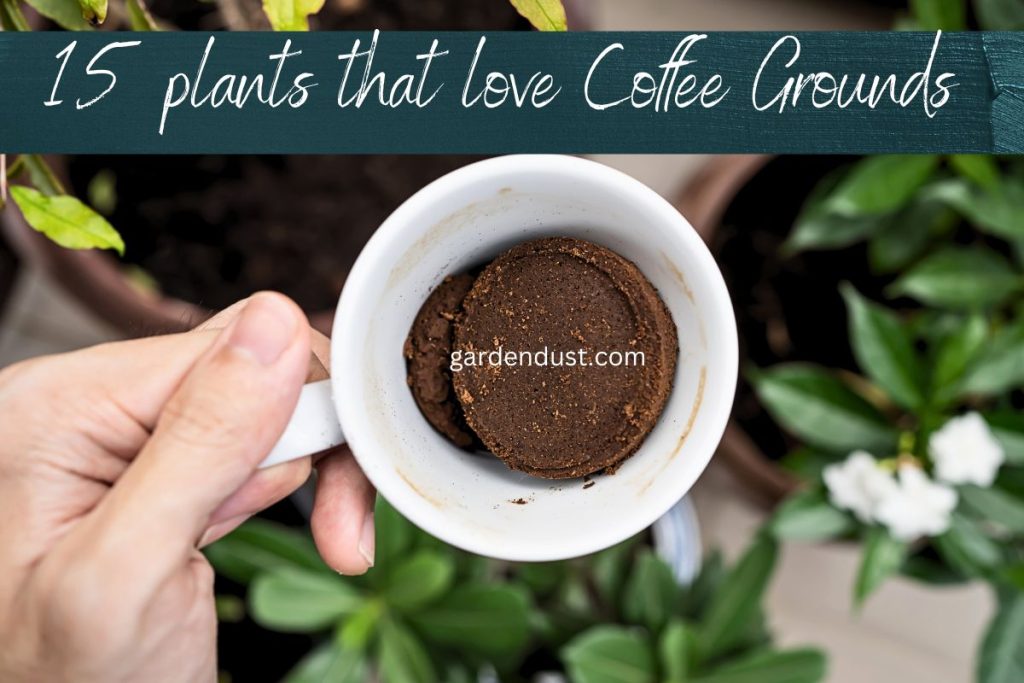For many of us, coffee is an essential part of our daily routine, providing that much-needed boost to kickstart our mornings. But what if we told you that your beloved cup of joe could also benefit your garden? Coffee grounds, often discarded as waste, can be a valuable resource for enriching soil and promoting plant growth. Coffee enthusiasts often find themselves discarding used coffee grounds without realizing the untapped potential within those dark, rich remnants. Surprisingly, coffee grounds are a valuable resource for gardening, offering a nutrient-rich boost to many plants. In this article, we will delve into the world of coffee ground composting and explore 15 plants that love coffee grounds which not only tolerate but thrive when coffee grounds are incorporated into their care routine. Let’s start…
15 plants that love coffee grounds
1. Roses (Rosa spp.)
Roses are classic garden beauties, and they love the acidity found in coffee grounds. Incorporating coffee grounds into the soil around roses enhances their growth by providing a steady release of nitrogen, a crucial nutrient for blooming flowers.
2. Tomatoes (Solanum lycopersicum)
Tomatoes, the stars of many vegetable gardens, benefit from the calcium content in coffee grounds. The grounds help prevent blossom end rot, a common issue in tomato plants. Additionally, the slow-release nutrients in coffee grounds contribute to robust and healthy tomato plants.
3. Blueberries (Vaccinium spp.)
Blueberries thrive in acidic soil, and coffee grounds provide just the right environment for these antioxidant-rich berries. Mixing coffee grounds into the soil helps maintain the necessary pH level and adds valuable organic matter for optimal blueberry growth.
4. Azaleas (Rhododendron spp.)
Azaleas, known for their vibrant and showy blooms, appreciate the acidic nature of coffee grounds. The grounds improve the soil acidity, promoting healthy root development and enhancing the overall appearance of these ornamental shrubs.
5. Hydrangeas (Hydrangea spp.)
Coffee grounds can influence the color of hydrangea flowers. For pink blooms, alkaline soil is preferred, while blue blooms thrive in acidic conditions. By adding coffee grounds to the soil, gardeners can manipulate the pH and achieve the desired color for their hydrangea blossoms.
6. Camellias (Camellia spp.)
Camellias, with their glossy leaves and elegant flowers, benefit from the organic matter and acidity provided by coffee grounds. These grounds help retain moisture and improve soil structure, creating an ideal environment for camellias to flourish.
7. Carrots (Daucus carota)
Root vegetables like carrots appreciate the light texture coffee grounds lend to the soil. The grounds also deter pests like carrot flies, making them an excellent addition to the carrot patch. Simply sprinkle coffee grounds around the base of the carrot plants for enhanced growth.
8. Strawberries (Fragaria × ananassa)
Strawberries enjoy the acidic boost from coffee grounds, and the nitrogen content encourages vigorous growth. Whether planted in the ground or containers, adding coffee grounds to the soil benefits strawberry plants by promoting healthier foliage and more abundant fruit production.
9. Rhododendrons (Rhododendron spp.)
Similar to azaleas, rhododendrons thrive in acidic soil conditions. Coffee grounds assist in maintaining the necessary pH level and contribute essential nutrients, resulting in lush foliage and vibrant blooms.
READ ALSO:-8 REASONS-WHY BOTTOM WATERING IS IMPORTANT?
10. Lettuce (Lactuca sativa)
Leafy greens like lettuce appreciate the nutrient-rich composition of coffee grounds. When mixed into the soil or used as mulch, coffee grounds provide a slow-release source of nitrogen, promoting the healthy growth of crisp and flavorful lettuce leaves.
11. Cucumbers (Cucumis sativus)
Cucumbers benefit from the nitrogen, potassium, and phosphorus present in coffee grounds. These nutrients promote strong vine growth and support the development of abundant and healthy cucumber fruits. Incorporating coffee grounds into the soil also helps with moisture retention.
12. Peppers (Capsicum annuum)
Whether sweet or hot, pepper plants respond positively to the addition of coffee grounds. The grounds contribute essential nutrients, including magnesium and calcium, fostering robust pepper plants with increased resistance to diseases.
13. Cauliflower (Brassica oleracea var. botrytis)
Cauliflower plants appreciate the nitrogen boost from coffee grounds, aiding in the development of large, compact heads. The grounds also improve soil structure, allowing for better water retention and drainage, both crucial factors in successful cauliflower cultivation.
14. Clematis (Clematis spp.)
These climbing vines benefit from the organic matter in coffee grounds, promoting healthy root development and supporting their vigorous growth. The grounds can be applied as a mulch around the base of clematis plants to improve moisture retention and provide essential nutrients.
15. Lily of the Valley (Convallaria majalis)
This fragrant and delicate perennial enjoys the organic matter coffee grounds bring to the soil. Adding coffee grounds to the planting area of lily of the valley enhances soil structure and provides a slow-release source of nutrients, contributing to the overall health and vigor of these charming flowers.
Coffee grounds, often seen as waste, can be a gardener’s secret weapon for cultivating a lush and vibrant garden. By incorporating coffee grounds into the soil, you not only recycle a byproduct of your morning routine but also provide your plants with a nutrient-rich boost. From roses to tomatoes, blueberries to lettuce, the list of plants that thrive on coffee grounds is diverse and expansive. So, the next time you brew your favorite cup of coffee, think twice before discarding those grounds—they might just be the key to a flourishing garden. Happy Gardening….






